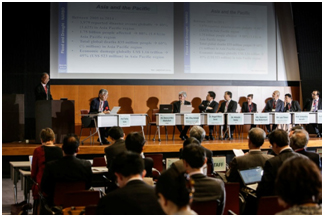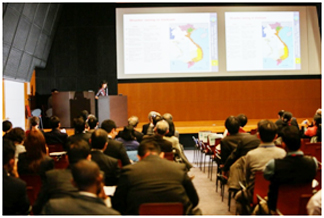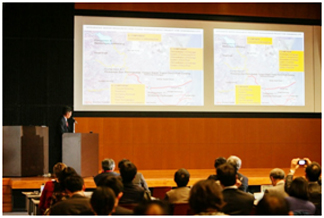NARBO
Spiral-up Development - Report of AWCS 2016
Tadashige Kawasaki
NARBO secretariat
![]()
Japan Water Agency (JWA), International Centre for Water Hazard and Risk Management (ICHARM) and the University of Tokyo held the Asia Water Cycle Symposium focused on flood and drought issues in the Asia-Pacific region from the viewpoint of the post-2015 framework (Sendai Framework) for disaster risk reduction (DRR) on 1-2 March, 2016 in Tokyo. Some part of the session was held as a celebration of 10-year anniversary of ICHARM. Approximately 160 participants from 20 countries joined and contributed to the discussions at the symposium. Chairperson of NARBO, delegates from JWA, PJT1 (Indonesia) and MARD (Viet Nam) also participated in the symposium and made presentations and introduced their activities in the field.
Panel Debate on ‘Flood and Drought in the Asia Pacific Region’ was held in the morning on 1st March, and Dr. Keizrul bin Abdullah, Chairperson of NARBO contributed to the discussion as one of the panelists. Dr. Abdullah talked about ‘Flood and Drought in the Asia Pacific Region’ and emphasized on the necessity of actions to address the changes by i) achieving water security and economic security; ii) continuous and sustained effort; iii) comprehensive and integrated approach; iv) adaptation / Flexible solutions to un-certainty; v) focusing on building resilience and reducing risk; vi) sharing knowledge and experiences; and vii) regional cooperation.
 |
NARBO contributed to the afternoon session on 1st March which focused on current situation and countermeasures against Floods in Asia by introducing activities of NARBO member organizations. Mr. Gede Nughoro Ariefianto, PJT1 introduced activities of PJT1 in the Brantas and Solo River basins such as community based flood early warning system as one of the practical activities. Mr. Dony Trio Prabowo, PJT1 introduced the challenges of the Toba Asahan and the Jratunseluna River basins which were newly added to PJT1’s mandate. Ms. Doan Thi Tuyet Nga, MARD talked about disaster risk management in the water resources sector in Viet Nam and introduced the challenges and solutions. Especially, Ms. Nga proposed and stressed the necessity of i) further improvement of the system of legal documents; ii) complete system of standards and regulations for disaster management; ii) building a complete, self-contained and synchronous irrigation construction system; iv) continuous implementation of the Project Community awareness raising and community based disaster risk management; v) application of information technology and space technology in disaster management and mitigation; and vi) application of advanced technology for more efficient water management in drought regions. Dr. Kentaro Kido, JWA talked about the flood control for typhoon 18 at the Yodo River System in 2013 and introduced the ‘Key for Success’ of the operation such as i) coordinated and cooperative operations for flood control facilities group in short time; and ii) implement “Best Possible operation with all flood control facility” by good coordination system, hydro meteorological data sharing system, keeping good condition of facility and equipment, and practical experiences and trainings for both decision maker and practitioner. Mr. Tadashige Kawasaki introduced the activities of NARBO as a NARBO secretariat and highlighted the necessity of bridging the gap between international discussions and research activities and field by enhancing NARBO activities.
 |
 |
|
| Source: AWCS 2016 website | ||
Followed by the introducing sessions, flood early warning system and flood disaster risk reduction were discussed as ICHARM 10-year Anniversary, and sessions to discuss drought and capacity building were also held on 2nd March. As a summary of the symposium, panel discussion on "Towards Water Disaster Risk Reduction in Asia and the Pacific Ocean Region" was held focusing on Collection and Statistics of Water Disaster Data, and Inter-disciplinary and Trans-disciplinary Cooperation and Promotion of Regional Cooperation. After the intensive discussions on how to bridge the gaps, Prof, Toshio Koike, Director of ICHARM wrapped up the discussion and introduced key directions and actions such as to i) improve collection, sharing, integration and dissemination of data; i) advance inter-disciplinary and trans-disciplinary research on flood and drought risk reduction; and iii) promote regional cooperation by mobilizing existing international initiatives for supporting local/national efforts. Prof. Koike emphasized the ‘Spiral-up Development’ approach through demonstration, prototyping and operation as conclusion. The seminar was a very good opportunity to create the new network with researchers and practitioners. NARBO secretariat will continuously make opportunities to link with international discussions and researchers by bridging the gaps.
You can see all the presentations and photos of the symposium at following website.
http://wci.t.u-tokyo.ac.jp/events/awcs2016/presentations.html
http://wci.t.u-tokyo.ac.jp/events/awcs2016/photo.html